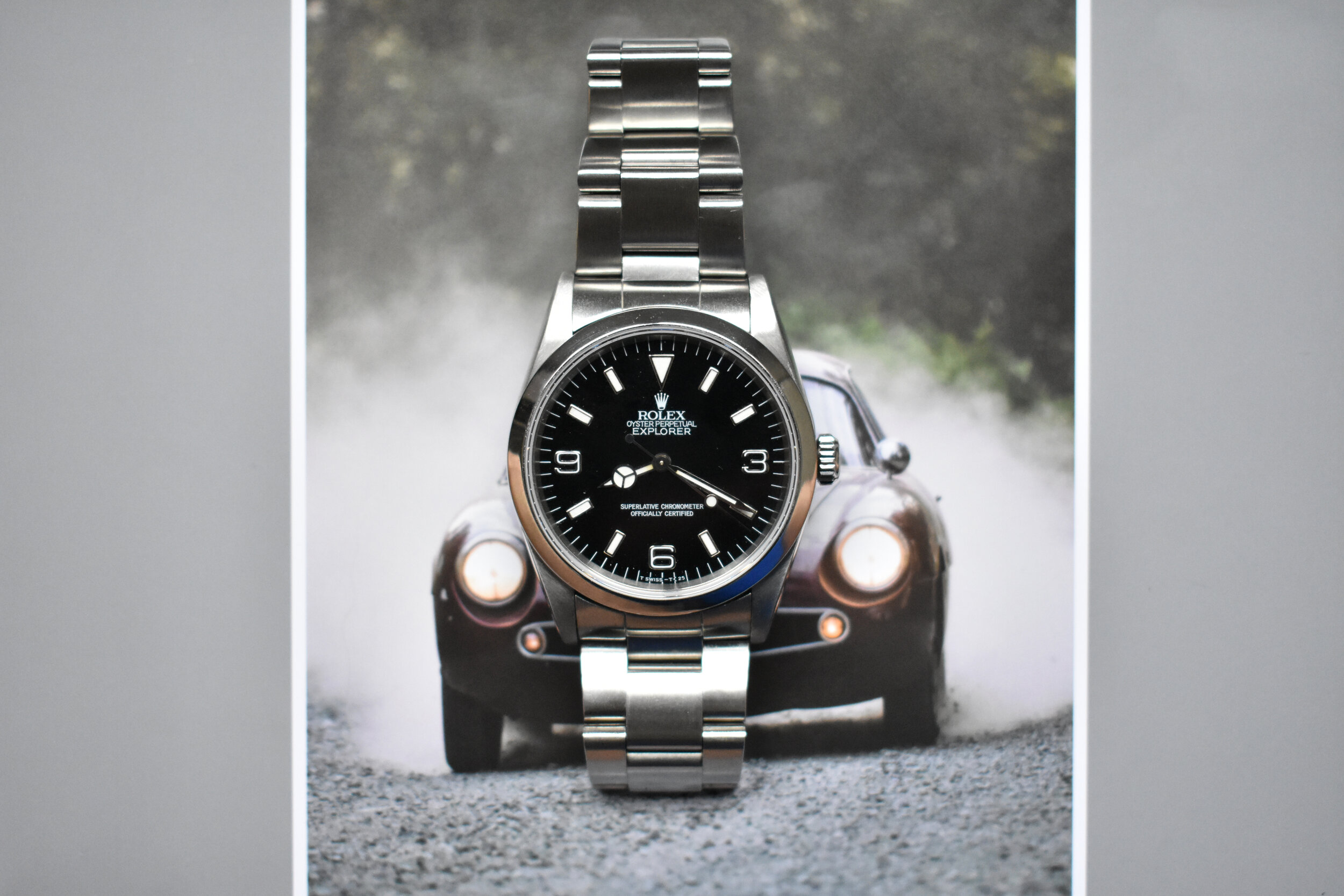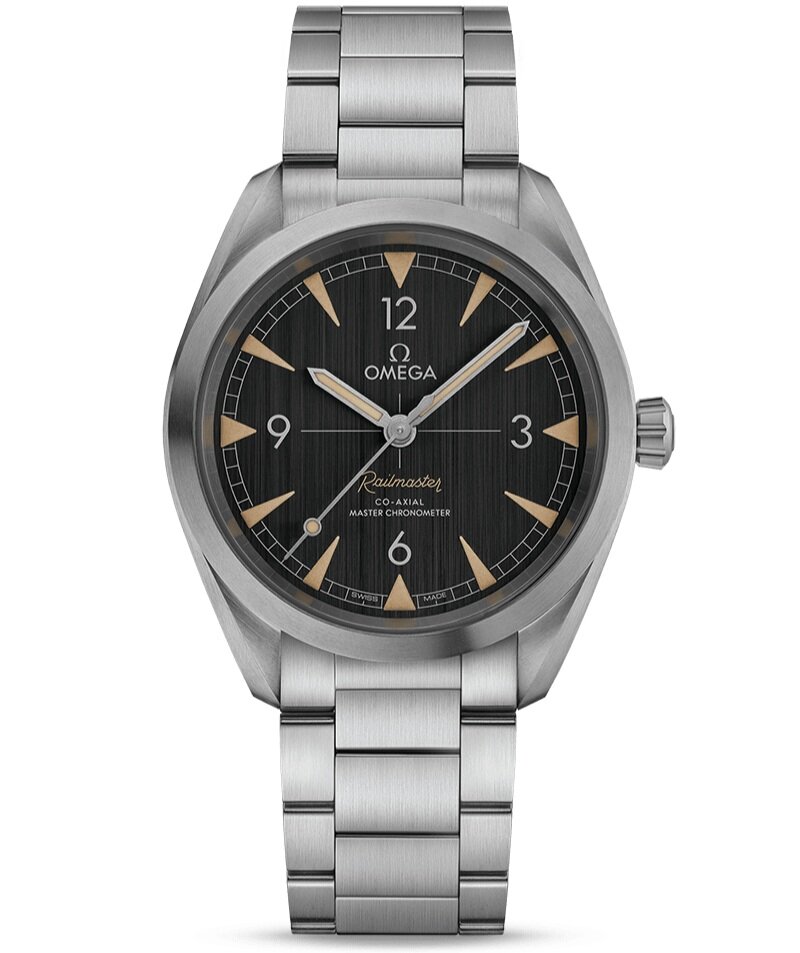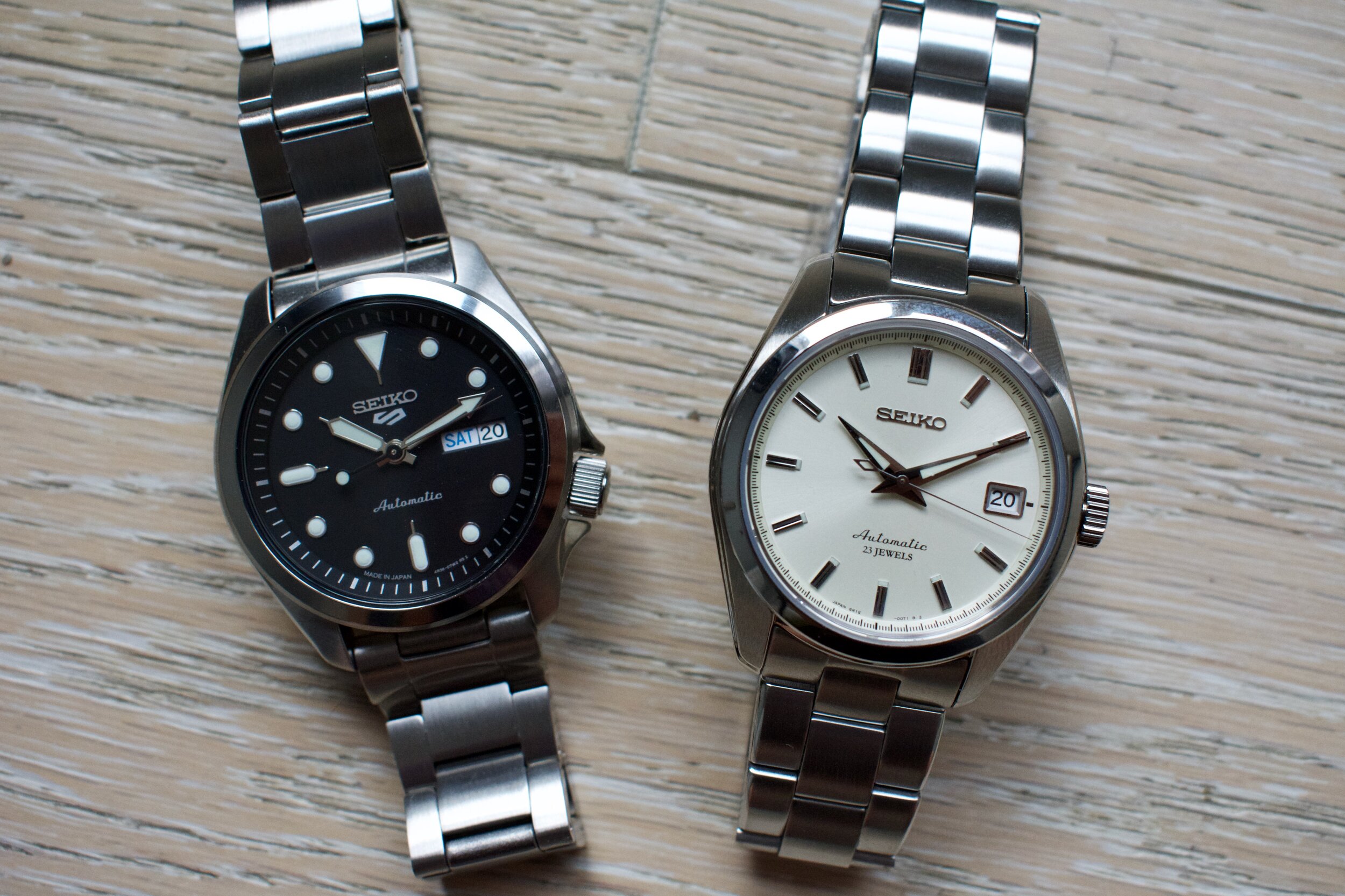Ah, the Rolex Explorer. Even saying the name nearly conjures images of mountaineers climbing to the top of Mount Everest. Fearless, Rolex on wrist. The Explorer’s form is practically as famous as its lore: Black dial, bold Arabic numerals at 3, 6 and 9, and, well, not much else. The Explorer’s status as icon is further cemented by the fact that any other watch with 3-6-9 Arabic numerals is relegated to the status of featuring an “Explorer dial.” The moniker is a hint that, while there’s nothing like the original, there are often (worthy) imitators.
The modern Rolex Explorer, Reference 214270, was released in 2010, and re-released in 2016 with slight modifications. It’s the first of the model’s line, which stretches back to the 1950s, to bump the case size up to 39mm from the traditional 36mm. Other than that, the form remains remarkably familiar: glossy black dial, modern Rolex caliber 3132, white gold surrounds on the markers, and of course, the immediately recognizable Arabic numerals.
While it’s not as difficult to obtain from a Rolex authorized dealer, as say, a Daytona or GMT-Master II, you’ll still likely find yourself waiting for a couple months before you get “the call.” Further, with a list price of $6,550, it’s firmly at the “entry-level” of Rolex’s collection, but there are certainly worthy alternatives at lower price points.
With that, let’s take a look at five alternatives to the modern Rolex Explorer Reference 214270.
Omega Railmaster
As always, perhaps the most obvious alternative to Rolex is Omega. Here, it’s the Omega Railmaster, a line dating back as far as the Rolex Explorer. What’s more, it’s also long featured those attractive Arabic numerals. Omega offers the Railmaster on a bracelet for just north of $5,000, providing an intriguing alternative with nearly as much heritage as the Explorer. The Railmaster was introduced as part of the Omega “Trilogy” in 1957 — alongside the Seamaster and Speedmaster — as a simple, anti-magnetic watch for railway workers. The modern version features a 40mm stainless steel case, a black dial with a vertically brushed pattern that provides additional texture, and Omega’s Co-Axial Master Chronometer Certified caliber 8806. Read a bit about Omega’s master chronometer certification process, where movements are certified at Switzerland’s Swiss Federal Institute of Metrology, and you’ll find yourself wanting one of these accurate-as-hell movements pretty quickly. Omega’s co-axial movement is a true innovation, and its continued commitment to providing the most accurate movements around is no less admirable. With that type of heritage, it’s not exactly fair to call the Railmaster an “alternative” to the Explorer since it’s recognizable in its own right, but it is perhaps the watch most similar to the Rolex Explorer.
Price: $5,200 on bracelet; Omegawatches.com
Tudor Black Bay 36 (or 41)
Tudor is Rolex’s offered (affordable) alternative to Rolex. And if the upsized 39mm case of the Rolex Explorer reference 214270 is a bit big for your classically-inspired tastes, the Black Bay 36 offers perhaps the closest alternative to a vintage Rolex Explorer in all of modern watches. The Black Bay 36 takes the form of the modern Tudor Black Bay — itself an icon — and strips it away nearly all diving pretense, leaving a simple, affordable watch. Smooth bezel, snowflake hands, hour markers more inspired by a Submariner than an Explorer, and a glossy black dial — the watch has a modern character all its own, but one that’s clearly rooted in the heritage of both Tudor and Rolex. The smiling self-winding text at 6 o’clock is a final detail that really makes the watch sing. Tudor cuts back on price by using an ETA caliber 2824, but by all accounts the brand works hard to tune and modify its movements so this is as accurate an ETA-powered watch as you’ll find.
Alternatively, if the Explorer feels a bit dainty to you, the Black Bay 41 provides an upsized-alternative with a 41mm diameter. Finally, the 39mm watch in Tudor’s lineup that can’t go without mention is the Black Bay 58. Of course, at a glance it looks to have nothing in common with the Explorer beyond case diameter. But, they’re both just damn good watches. And at under $4,000, the Black Bay 58 (blue or black dial) is hard to beat. I’m something of a proponent of “buying the icons” — look to the flagships of a brand’s stable of models when you’re making a purchase; you know those will be in style 20 years from now (and, were likely in style 20 years ago). Many models come and go, but the icons are here to stay. While only a few years old, the Black Bay 58 (and, of course, the Explorer) is one of those icons. Take a look at the Black Bay 58 while you’re at the boutique too.
Black Bay 36: $2,800 (on bracelet); Tudorwatch.com
Nomos Club
Glashutte, Germany-based Nomos was pretty much built on making affordable watches that anyone can love. It offers a number of models that might be considered alternatives to the Rolex Explorer. Perhaps the brand’s sportiest line is the Club. While the original model is a 36mm, manually-powered movement, the Club line has expanded to include a number of dial varieties and movements. For the closest alternative to the Rolex Explorer, look to the Club Automatic. It measures 38mm, features those attractive Arabic numerals at the even markers, and is powered by Nomos’ fully in-house DUW 5001 caliber. When you read a bit about Nomos’ efforts to develop its own in-house escapement to become a fully independent watch manufacturer, it’s hard not to appreciate the young brand even more. Most of Nomos watches are downright affordable, and the Club line is no exception: a manual wind starts at about $1,500, while an automatic will set you back about $2,500. Unlike other brands, Nomos isn’t afraid to sell pre-owned, refurbished examples of its own watches (even on its own website!), making you feel even better about the value you’re getting.
And if you just have to have a black dial, there’s also the Club Campus 38 Night.
Club Automatic: $2,620; nomos-glashuette.com
Grand Seiko SBGR301 or SBGA211
For the Grand Seiko that offers the most obvious aesthetic alternative to the Rolex Explorer, look no further than the SBGR301. Black dial, no date, 42mm case, and no nonsense. At $4,300 and readily available at authorized dealers, it’s a watch that’s all business that can serve admirably for years to come. While still dressy, it’s a bit sporty compared to some other Grand Seiko models, and about as sporty as you’ll get from the brand’s classic “Heritage” lineup.
But, as I mentioned, I’m all about “buying the icons” — identifying the modern classics and going for it. For Grand Seiko, that means two things: first, the Spring Drive movement; second, dials inspired by the natural elements of Japan. As to the latter, specifically, this means the brand’s “Snowflake” dial, first introduced in 2010. The Snowflake is honestly one of the most beautiful things in all of watchmaking — vaguely resembling freshly fallen snow, but in reality something completely its own.
The Grand Seiko SBGA211 features the Snowflake dial and is powered by the brand’s Spring Drive movement. It’s a movement that features most of the components of a mechanical watch, but for the escapement, which is instead an electrically-powered glide wheel. If that sentence is nonsense, no worries: the end result is a seconds hand that moves smoothly across the dial, instead of the 1/6th (or whatever beat rate) minute jumps typical of a mechanical watch. Powering blue steel hands across the Snowflake dial, the result is one of the most cool, calm feats watchmaking might ever see, unless President Obama eats a bunch of cucumbers and himself becomes a watchmaker.
So, is a white dial, dress watch from Japan a true “alternative” to the Rolex Explorer? No, I guess not. But, it’s no less an icon worthy of your consideration.
SGBA211: $5,800; Grand-Seiko.com
Seiko SARB033
While Grand Seiko offers a downright value compared to its Swiss counterparts in the luxury space, Seiko continues to do the same in the “affordable” category. While recently discontinued, the Seiko SARB033 is a hell of a watch. At about the price of an Apple Watch, you get everything you’d ever need from a mechanical ticker: solid stainless steel case and bracelet (measuring 38mm in diameter), display case back showing a reliable Seiko 6R15 caliber, and a form that one might mistake for a Rolex from a distance. With it no longer available new and direct from Seiko, prices continue to inch upwards, so grab one while you can. Read my full take on the Seiko SARB033 (and its white-dialed sister, the SARB035) here, but to take a bit about how the watch wears:
So how do the Seiko SARB033 and 035 wear? Well, like a watch. It’s perhaps the ultimate-don’t-think-just-do mechanical watch. Clip on the bracelet or throw it on a strap, and you’re good to go. There’s a date window if you need it, but who’s got time to set the date? At about 11mm thick and with a sapphire case back, it sits a bit tall on the wrist, but that’s just to remind you it’s there, and that hey, you’re a bad ass for wearing a mechanical watch in 2020 A.D. Every example I’ve had has seemed to tick more reliably than Seiko’s reported +25/-15 seconds per day — the spec sheet is just as humble as the watch itself!
At the risk of making this a Seiko party, the new Seiko 5 Sports offers an even better value at a couple hundred bucks. Again, check out my full review here, but to summarize:
At first glance, the new Seiko 5 Sports is perfect: the dimensions are right in a goldilocks range; the dial is austere but exquisitely executed; the smooth bezel is attractive without being garish. Especially important: It pops on Instagram, with the look of a watch multiple times its $275 price tag. Sure, there are some details to quibble with: The oyster-style bracelet, with just two micro-adjustments, seems like an afterthought. But, these complaints largely miss the point: This is a watch for the masses, with features newcomers need and details enthusiasts will love.
SARB033: ~$400; Amazon.com
Bonus Pick
Explorer Reference 14270
I know, an Explorer as an alternative to an Explorer? It’s counter-intuitive, if not downright lazy. But hear me out. Through the 1980s and 1990s, Rolex went through a “transitional” period where it updated its models from classic, vintage styling to the modern, luxury form we know today. To me, it resulted in some of the best watches in Rolex’s back catalog. And, because they’re not as rare as vintage models or desirable as modern ones, they remain relatively affordable.
Take, for example, the best transitional Rolex — in my opinion, of course — the Explorer reference 14270. The follow-on to the long-running Explorer reference 1016, the reference 14270 was just the update the Explorer line needed after remaining unchanged for nearly three decades. I’ve dug more in-depth on the entire history of the Rolex Explorer before, but you don’t need to buy into the whole summiting Mount Everest history to get why the reference 14270 is a nearly perfect watch.
The Rolex Explorer is the perfect everyday watch, and I’m of the opinion that the reference 14270 is the ultimate embodiment of that ethos. With some more upgraded and luxurious details than the reference 1016, but not quite the total in-your-face modern luxury that modern Rolex stands for, the reference 14270 strikes the ultimate balance between functionality and opulence. While you can’t buy it new, you can find the Explorer reference 14270 from dealers and other sites like eBay or Chrono24.










Guide
Sometimes, 38mm is all you need in a dive watch.